|
1.
CENTRAL/ WEST AFRICA
Log trade eases in West Africa
The recent frenetic log buying triggered by the Gabon log export ban appears to be easing off as buyers consolidate purchases and plan procurement and production for the reminder of the year.
This lull in buying also gives time for the authorities in Cameroon and Congo Brazzaville to review their regulations on log exports for the second half of the year.
Currently, small volumes of logs are also exported from the Democratic Republic of Congo and the Republic of Equatorial Guinea.
Hope for a rethink on log export policy
According to some sources, the government of Gabon is assessing the impact of the log export ban on the economics of timber extraction, in-country processing, exportation and forestry sector employment.
Optimists in the industry are hoping that the system discussed around two months ago to tie log export quota to in-country processing would be revived. However, officials have not given any indication that the total on log exports will be relaxed.
Earlier this year, the Gabon State Timber Export Inspection Agency (SNBG) was assigned to export logs felled prior to end of December 2009. If this state enterprise is to remain viable, it is possible that it would be the first choice as the agency to manage any resumption of log exports.
As early as 2009, regulations on a log export quota tied to in-country processing were supposed to have come into effect. However, the global market downturn and weak demand, especially for sawnwood, left the authorities in Gabon with little economic choice but to continue log exports.
Sawnwood market remains subdued
The sawnwood market situation has not improved and trade is slow with no signs of any major changes for the third quarter.
Analysts suggest that there may be some pick up in orders in late August at the close of the European vacation season, but apart from this, the prospects are not for any immediate recovery in demand for sawnwood. Sawnwood and log prices were unchanged through June 2010.

2. GHANA
Wood product exports pick up
Ghana¡¯s accumulative wood product exports in the first five months of 2010 amounted to 166,920 cu.m, worth EUR55 million. Compared with the same period last year, exports showed a 3.1% increase in volume and a 10% rise in value.
For the period under review export volumes of both air and kiln dried boules, air and kiln dried sawnwood, and mouldings increased 58%, 15%, 27% and 16% respectively in comparison to the same period in 2009.
The drop in the exports of veneers and other wood products is attributed to inadequate log supply and decreased export contracts.

Government¡¯s strategies to assist timber industry
The Ministry of Lands and Natural Resources has announced short, medium and long-term strategies to assist the Ghanaian timber industry.
The sector Minister, Alhaji Collins Dauda, said that the short-term plan is to waive import levy on logs to enable processing industries run at higher capacity. Also, the annual allowable log harvest will be raised from 1 million to 2 million cubic meters, making more wood available for the timber industry.
Under the medium-term strategy, a voluntary agreement between the government of Ghana and entrepreneurs will be introduced to retool inefficient processing mills to ensure optimal utilisation of wood resources and reduce waste.
In the long term, the ongoing National forest Plantation Development Programme will be geared towards increasing wood supply for the industry. The programme target is to increase the plantation area by 30,000 hectares per annum.
The long-term plan is also to increase research on lesser used timber species, since despite promotion efforts, only 60 out of 250 timber species from Ghana have been
commercialised.
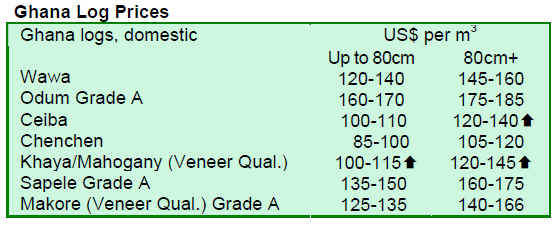
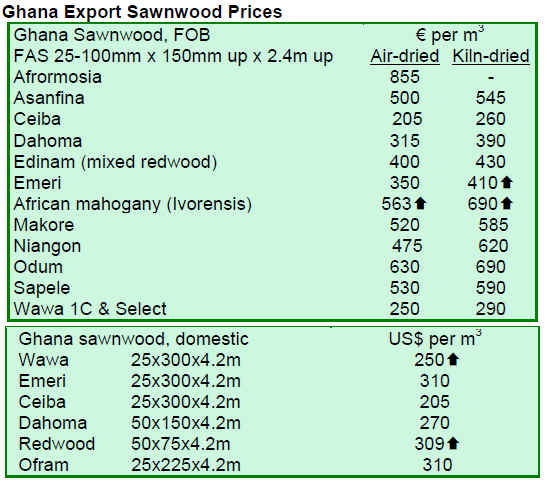
3.
MALAYSIA
MTIB targets RM53 billion exports by 2020
The Malaysian Timber Industry Board (MTIB) targets RM53 billion in wood and timber product exports by 2020. The target is achievable if the current trend in sales continues, says an analyst.
The Malaysian timber industry is recovering after two years of recession. Exports of Malaysian wood and timber products reached RM6.9 billion in the first four months of 2010, up 22% from the same period in 2009.
Sungai Pinangah achieves milestone towards certification
Some 188,610 hectares of forests in Sungai Pinangah Forest Reserve managed by the Yayasan Sabah Group have attained the Verification of Legal Compliance (VLC) from the Rainforest Alliance under its SmartWood certification programme. The VLC was the first to be granted in Sabah. Earlier, the same forest area had received the Smartwood Standard for Verification of Legal Origin (VLO).
The acquisition of the VLO and VLC is a requirement for the attainment of full certification under the FSC.
The Rainforest Alliance is working with Yayasan Sabah¡¯s Innoprise Corporation Sdn Bhd and the Forest Research Institute of Malaysia (FRIM) to fulfil the Reduced Impact Logging contract singed in 1992 between the New England Power Company of Boston and Yayasan
Sabah.
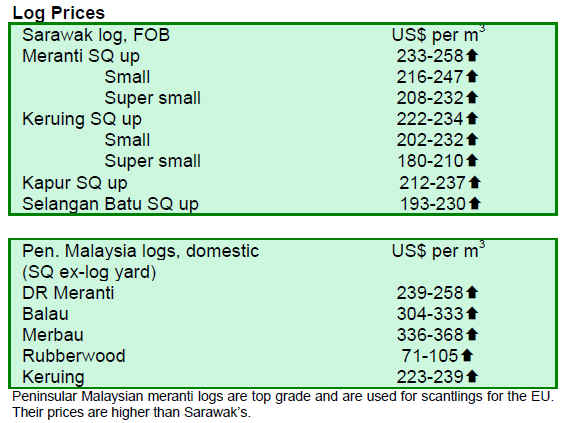
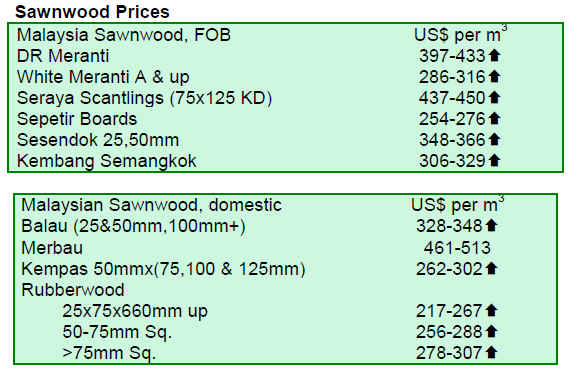
4.
INDONESIA
US Export-Import Bank extends trade financing facilities to Indonesia
The Export-Import Bank of the United States (Ex-Im Bank) has initially approved trade financing facilities up to US$1 billion to 11 banks in Indonesia aimed at promoting US exports to Indonesia.
The facilities will be available to private and public sectors in Indonesia, targeted at boosting public procurement in the Republic.
The eleven banks are the Indonesian Exim Bank, Bank Mandiri, Bank Negara Indonesia (Central Bank of Indonesia), Bank Rakyat Indonesia, Bank Central Asia, Bank Danamon, Bank Panin, Bank CIMB-Niaga, Bank OCBC Indonesia, Bank Internasional Indonesia, and Bank UOB Buana.
Emerging handicraft market in Egypt
Egypt has shown great interest for wooden and other handicraft products from Indonesia as demand for these products is evolving. Indonesia eyes Egypt as a gateway for its products into both the African and European markets.
Egypt and Indonesia have signed a memorandum of understanding ranging from pest management to handicraft production in Egypt under which Indonesia will provide training and technical assistance.
AFD loan for climate change programme
Indonesia has received a US$300 million loan from the Agence Francaise de Developpement (AFD) for the implementation of climate change policy programme.
The ADF steering committee meeting in 2009 outlined several objectives, goals and activities for Indonesia which were translated into a three year policy programme for climate change. The programme involves mitigation (forestry, energy), adaption (agriculture, water sources) and cross-sectoral issues.
Managing REDD funding
Currently, the financial mechanism for the Reducing Emissions from Deforestation and Forest Degradation (REDD) scheme in Indonesia has not been finalised. This is preventing local people from receiving money for their efforts to protect forests, remarked the Director of Environmental Services in Forestry Ministry Tony Suhartono.
The Indonesian government is implementing REDD pilot projects with local and international organisations in Central Kalimantan, East Kalimantan, East Java and West Nusa Tenggara provinces.
Recently, the Norwegian government pledged US$ 1 billion for forest conservation projects in Indonesia including under the framework of the REDD Plus. The Indonesian government has decided to set up an agency specifically to manage the fund.

5.
MYANMAR
Teak and pyinkado trade
Teak buying for the Thai market is completely stagnant while demand for pyinkado from China and Vietnam was steady through June 2010.
India remains the biggest importer of both teak and pyinkado in June 2010. Some buyers reported an oversupply of pyinkado logs in the Indian market.
Impact of exchange rates on timber market
The Myanmar Timber Enterprise uses Euro in its tender sales and US$ in its direct sales contracts. Some traders have been able to take advantage of fluctuating exchange rates and so the trade has picked up. According to some analysts, a slight easing of sales and shipments is possible if exchange rates become more stable.
India is experiencing a shortfall of logs stemming from the log export ban in Gabon. As a result, India continues to buy Myanmar teak, despite the recent depreciation of the Rupee against the US dollar. The US$ exchange rate was Rs. 44.41 on 2nd April and Rs. 47.71 on 25th May. However, the Indian teak buying market absorbed the exchange rate differentials even when the US$ rose to above Rs. 50.
Teak remains in demand in India and the steady flow of teak from Myanmar to India is expected to continue, says an analyst. However, India has a substantial stock of teak on its own to exploit if importing becomes uneconomic.
MTE list prices
The following price tables show Myanmar Timber Enterprise (MTE) list prices for direct sales contracts in use since September 2008. All prices quoted are US$ per Hoppus ton. Current tender market prices are US$200 to 250 per Hoppus ton over the MTE list prices.
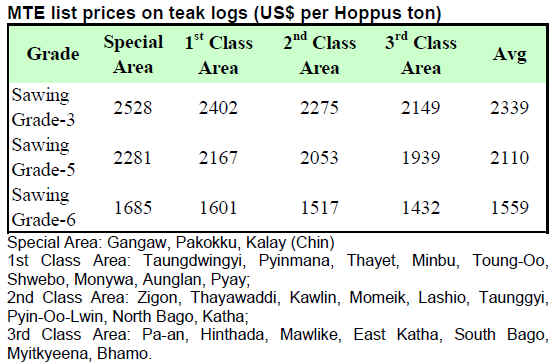
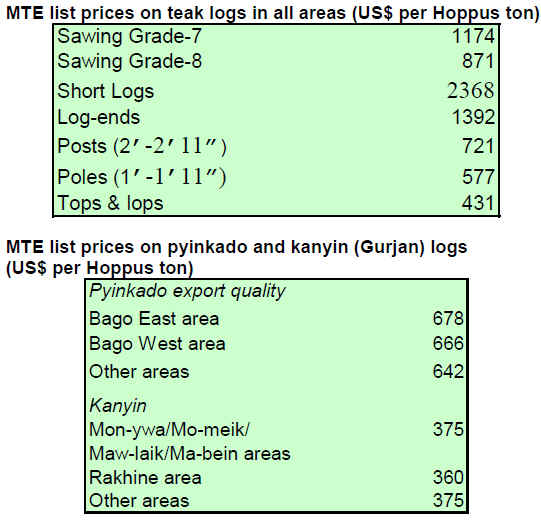
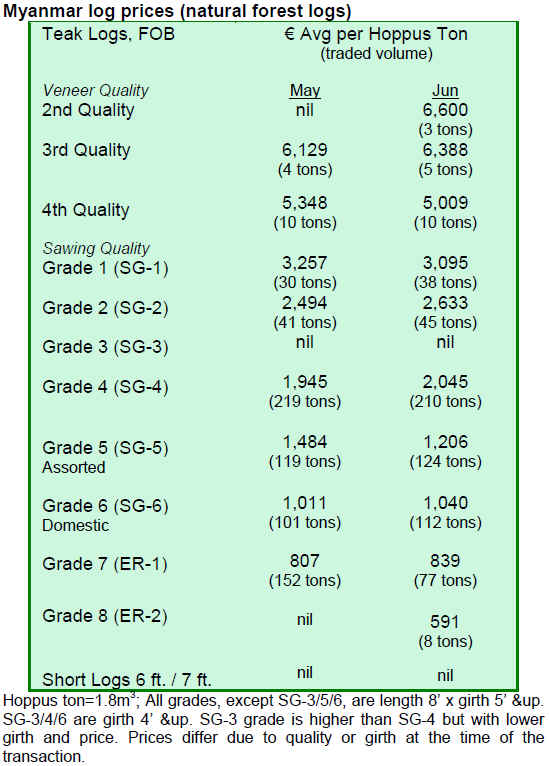
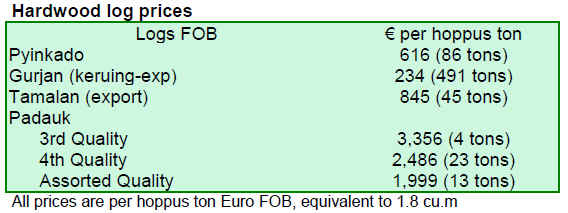
6. INDIA
India to double forested land area in next 10 years
The draft ¡°Green India Mission¡± recently published by the Ministry of Environment and Forests, envisages doubling afforestation and eco-restoration efforts over the next 10 years. This mammoth effort is expected to cost Rs.440 billion over the next decade involving some 10 million hectares of land across the country.
The mission targets all types of forests, grasslands and scrub, mangroves, urban forest land as well as degraded agricultural and fallow land. The mission is expected to reduce greenhouse gas emissions about 6%.
Industrial growth surge
In April 2010, Indian Industrial Production surged 17.6% over the level in April 2009. The growth is close to a record high of 17.7 % chalked up in December 2009. Since October 2009, Industrial Production Index has shown double-digit growth with robust private consumption and investments being the supporting factors. India is targeting an annual 20% growth in industrial production.
Market trends
The South West Monsoon season has started, causing a break in housing activity and easing domestic demand for wood products.
Plywood market seems to have settled down after the recent price increase imposed by domestic plywood manufacturers. However, a shortage of raw material and labour reportedly continues to hamper plywood production.
Hardwood auctions
Auctions of teak continued to attract active buying in the Central India log depots with US$38-57 per cu.m higher prices than in previous auctions. Sawing quality teak logs 3 metres and up fetched around US$1359 per cu.m, medium quality US$1133 per cu.m and logs between 2 and 3 metres long were priced at around US$906 per cu.m.
The hardwoods including haldu (Adina cordifolia) and kalam (Mitragyna parviflora) were the main non-teak species traded with prices around US$227 per cu.m for small dimension logs. Demand for South East Asian logs was brisk and the most popular species were balau, kapur, meranti, merbau and
rengas.
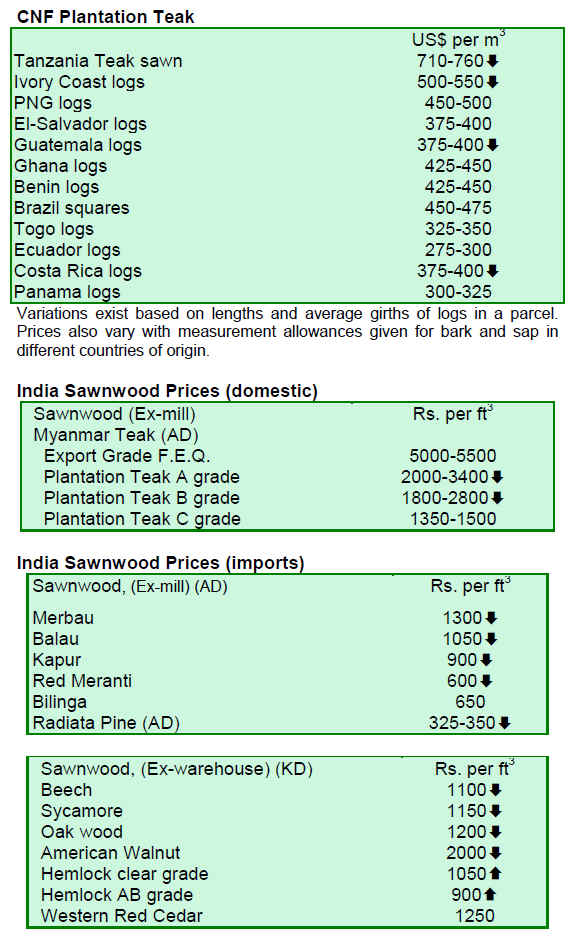
7. BRAZIL
Par¨¢ remains Brazil¡¯s major timber producer
In 2009, the total tropical roundwood harvest in Par¨¢ was 6.5 million cu.m. The total revenue collected by the Par¨¢ state from logging was R$2.1 billion, about half of country¡¯s gross revenue of the whole timber industry in 2009 (R$4.94 billion).
Par¨¢ was also the biggest roundwood consumer (46%), followed by Mato Grosso (28%) and Rondônia (16%).
In 2009, Par¨¢ produced 2.5 million cu.m of logs accounting for nearly half of the total log volume (5.8 million cu.m) produced in the Brazilian Amazon. The second biggest log producing state was Mato Grosso with 1.7 million cu.m.
Across the Amazon region, over a thousand timber companies generated 203,701 direct and indirect jobs, out of which 92,423 were in Par¨¢.
The timber sector production figures for 2009 were published by the Brazilian Forest Service (SFB) in the report "The logging activity in the Brazilian Amazon: production, revenues and markets".
Tropical timber exports down slightly
In May 2010, exports of timber products (except pulp and paper) jumped 27% compared to values in May 2009, from US$177 million to US$226 million.
However, pine sawnwood exports fell to US$13.4 million in May 2010, down 1.5% in comparison to May 2009. In terms of volume, May 2010 exports were down 16% from 71,200 cu.m to 59,500 cu.m year-on-year.
Exports of tropical sawnwood all fell both in volume and in value, from 46,700 cu.m in May 2009 to 44,400 cu.m in May 2010 and from US$22.5 million to US$21.2 million, respectively over the same period.
In contrast, pine plywood exports surged 80% in value in May 2010 compared to the same period of 2009, from US$21 million to US$37 million. The export volume rose 21% during the same period, from 82,800 cu.m to 100,300 cu.m.
In May 2010, exports of tropical plywood remained unchanged at US$5.0 million in value compared to May 2009. In terms of volume, a 5.1% decrease was recorded over the period, from 9,800 cu.m to 9,300 cu.m.
Mato Grosso timber exports rose in April
In April 2010, Mato Grosso exported 1,348 cu.m of roundwood, slightly over 27,000 cu.m of sawnwood and 18,603 cu.m of plywood and profiles. The timber industry accounted for 3.5% of state¡¯s total exports in April 2010, while the figure was 1.2% in April 2009.
In April 2010, timber sector in Mato Grosso employed 57% more than in April last year. The forestry sector is the fifth largest sector in terms of employment in the state.
Furniture manufacturers foresee growth in exports
A group of entrepreneurs in Rio Grande do Sul has initiated ¡°Orchestra Brazil¡±. Together with the largest Brazilian cluster, Bento Gonçalves, business partners in six other states and suppliers of furniture components and accessories, Orchestra Brazil is set to increase exports.
Orchestra Brazil brings together 65 companies from Rio Grande do Sul, Santa Catarina, Paran¨¢, São Paulo, Bahia and Rio Grande do Norte. The project aims at expanding furniture exports especially to other Latin American countries, Central and Southern Africa, United States and Europe. The project will run through to 2011. The expectation is for a 5% growth in exports this year and 15% next year.
By consolidating the production and supply chain, the project aims at creating added value and competitiveness for the Brazilian furniture sector.
Orchestra Brazil is coordinated by the Bento Gonçalves Furniture Industry Association (SINDMÓVEIS) in support of the Brazilian Agency for Export and Investment Promotion (APEX) and the Brazilian Micro and Small Business Support Service (SEBRAE).
Prime interest rate raised to check inflationary trend
According to the Brazilian Institute of Geography and Statistics (IBGE), the Consumer Price Index (IPCA) rose by 0.43% in May 2010, but stayed under the rate of 0.57% recorded in April 2009.
The cumulative IPCA from the beginning of the year reached 3.05% higher than the rate of 2.18% recorded in the same period of 2009.
In May 2010, the average exchange rate was BRL 1.81/US$, compared with BRL 2.06/US$ in May 2009, reflecting the continuing appreciation of the Brazilian currency against the US dollar.
The Copom (Economic Policy Committee) raised the prime interest rate (Selic) to 10.25% per year, to keep inflation within the target range.
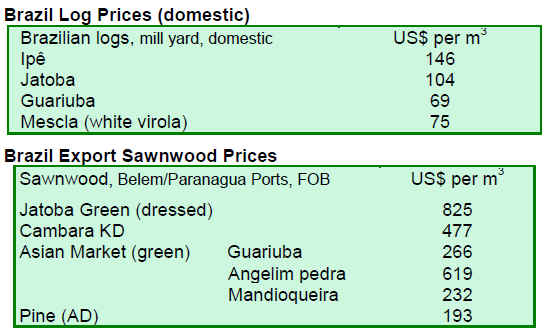

8.
PERU
April exports register strong growth
The Export Association of Peru (ADEX) has reported that April 2010 exports of wood products were US$ 15.4 million, up 36% from the levels in April 2009. Three main buyers were China, United States and Mexico which together accounted for 82% of the total export volume.
Parquet export to Sweden continued to grow in April and were up 193% from April 2009. Taiwan PoC increased its imports of sawnwood and plywood. Canada cut down parquet demand by 14% while Chile curtailed furniture and plywood imports by 14%.
Range of wood product exports
The main exported items in April were semi-manufactured products representing 47% share of the total volume. The accumulated exports from the beginning of the year totalled US$ 24 million representing a 28% increase over the same period in 2009.
Semi-manufactured products were exported mainly to China which accounted for 80% of the total accumulated exports from the beginning of the year.
Sawnwood exports made up 33% of the total exports. The accumulated sawnwood exports from the beginning of the year totalled US$17 million, up 23% over the same period last year. The main destination was China with a 39% share of the total sawnwood exports.
Accumulated veneer and plywood exports from the beginning of the year valued at US$5.5 million in April, up 28% over the same period last year. Veneer and plywood are exported mainly to Mexico accounting for over 97% of total exports.
In contrast, furniture and its parts exports continued to decline showing an 18% drop in accumulated exports from the beginning of the year. The total value of furniture and furniture parts exports for the period was US$2 million. The US and Italy have reduced imports by 71% and 34% respectively from the beginning of the year.
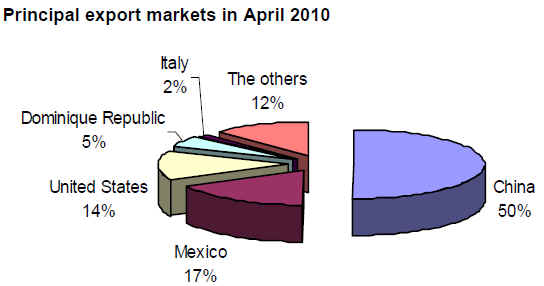
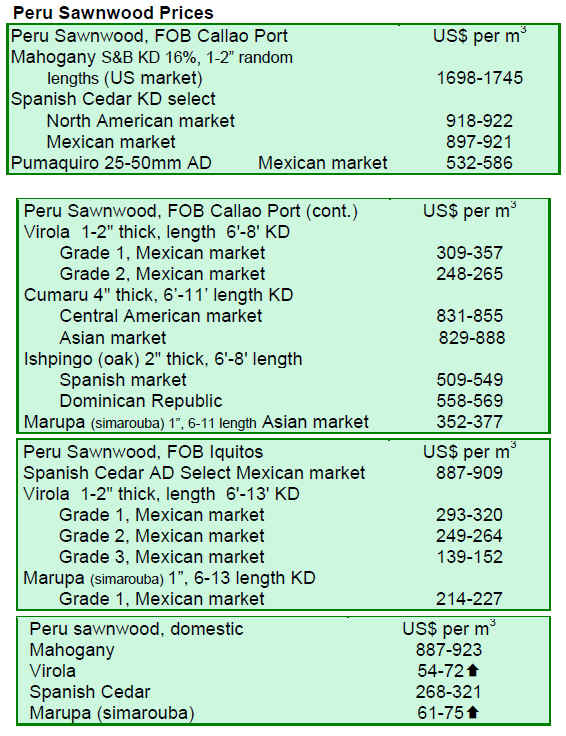
9. BOLIVIA
Forest product exports surge
Forest product exports from Bolivia totalled US$64 million in the period from January to April 2010, up 25% from US$51 million in the same period last year.
The main reason for brisk exports is the recovery of imports by the US, which is the principal market for Bolivian forest products.
Furniture, doors, panels, decking (as well as peeled chestnut and canned palm hearts) account for 80% of the total forest product exports, while the remaining 20% consists of primary processed wood products, such as sawnwood and poles.
The US remains the major market for Bolivian forest products taking some US$13.5 million, which accounted for 21% of the total forest product exports from Bolivia. Other major export destinations were the UK (US$9.5 million), the Netherlands (US$4 million), Venezuela (US$3.7 million) and Germany (US$2.6 million).
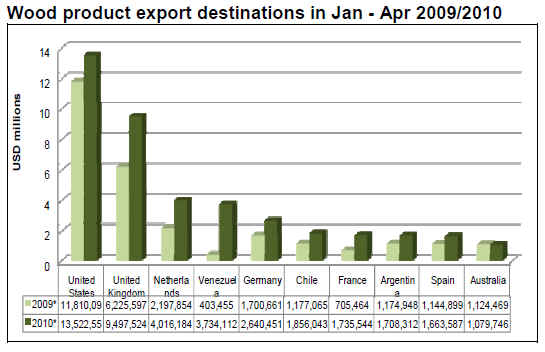

10. GUYANA
Market trends
The log export trade has slowed recently as producers concentrate on sawnwood production to meet strong domestic demand stemming from the active domestic housing sector. However, exports of purpleheart continued with relatively stable prices compared to the previous fortnight period.
Prices for rough sawn (undressed) greenheart (select) sawnwood improved as did the prices for purpleheart and mora.
Dressed greenheart prices fetched US$1187 per cu.m, up from US$1060 recorded in the previous fortnight period, while prices for dressed purpleheart remained stable. Some other dressed sawnwood species including bulletwood (macaranduba) kabukalli (cupiuba) and red cedar (cedro) also recorded price increases and contributed significantly to the total export earnings for this fortnight period.
Baromalli plywood in both BB/CC and utility categories recorded higher prices compared to the levels two weeks ago. Also prices for roundwood, fuelwood and wallaba splitwood (shingles) gained and exports increased.
Some of the exported value-added products with an upward trend in prices during this fortnight were outdoor garden furniture made from locust (courbaril, jatoba) and mouldings from red cedar (cedro) and crabwood (andiroba). Other exported value-added products were handicrafts, doors, door components and indoor furniture.
Legality Assurance System for the forestry sector
The Forest Products Development and Marketing Council of Guyana (FPDMC) has recognised the importance of an effective legality assurance system for the forestry sector. In terms of institutional arrangements, the FPDMC is envisaged to be the national governing body in charge of the Guyana Legal Assurance System and Chain of Custody.
An Awards and Oversight Committee will be in place to provide oversight for auditor selection, granting of certificates and quality control. The Guyana National Bureau of Standards (GNBS) will be responsible for issuing certificates. An international review body will be appointed to review / audit the system to assure its compliance internationally.
The FPDMC and GNBS are working closely together to complete the standardisation which will be a critical step towards internationally recognised certification for Guyana¡¯s forestry sector. According to reports, licenses to be issued under the Legality Assurance System will be both ¡°shipment based¡± and ¡°operator based¡±.
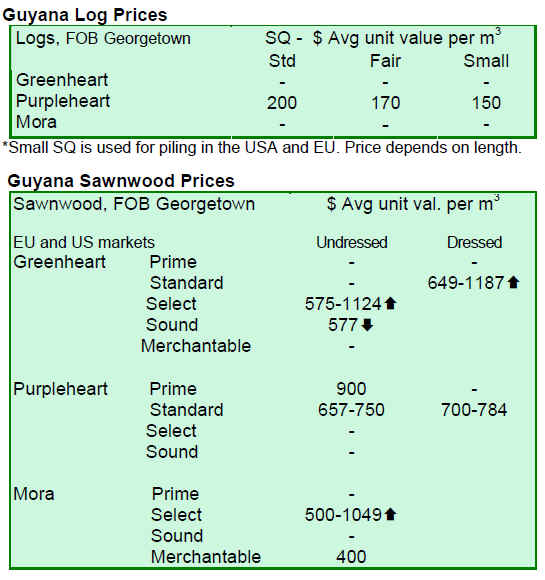
Related News:
|